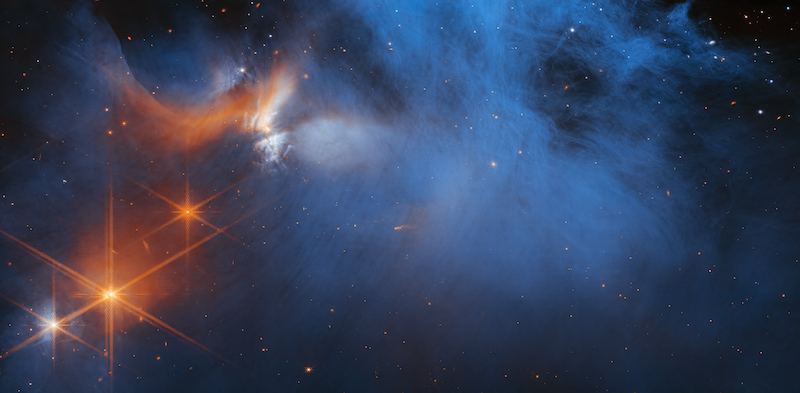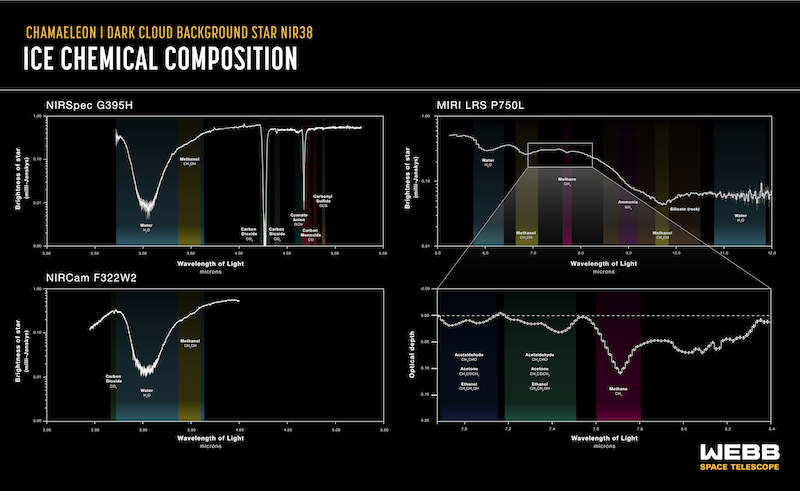
Molecular clouds are vast interstellar clouds of gas and dust. They are the coldest and densest such clouds in the interstellar medium, the region of space between stars. They can also be the birthplace for new stars. On January 23, 2023, an international team of astronomers reported that NASA’s Webb telescope discovered a wide range of molecules, in frozen form, inside a cold, dark molecular cloud called Chamaeleon I. These are pre-stellar molecules, meaning molecules present in the cloud before the beginning of star or planet formation. Indeed, they could become ingredients of future exoplanets or even the building blocks of life itself.
Chamaeleon I, part of the Chamaeleon complex, is located about 630 light-years from Earth. Dozens of young stars are currently forming inside its depths. Hence, astronomers refer to molecular clouds like this as stellar nurseries. The observations are part of the Ice Age project, one of Webb’s 13 Early Release Science programs.
The researchers published their peer-reviewed results in the journal Nature Astronomy on January 23, 2023.
Webb discovers ices in molecular cloud
These ices are the deepest and coldest ever found so far inside a molecular cloud. They include a diverse range of molecules such as water, carbonyl sulfide, ammonia, methane and methanol. Melissa McClure, an astronomer at Leiden Observatory in the Netherlands, principal investigator of the observing program and lead author of the new paper, stated:
Our results provide insights into the initial, dark chemistry stage of the formation of ice on the interstellar dust grains that will grow into the centimeter-sized pebbles from which planets form in disks. These observations open a new window on the formation pathways for the simple and complex molecules that are needed to make the building blocks of life.
Methanol and complex organic molecules
The discovery proves that complex molecules can form in molecular clouds. This is based on the fact that Webb also found evidence for molecules more complex than methanol (methanol is the simplest of the more complex organic molecules). This, in turn, suggests that the precursors to prebiotic molecules are common in star formation. Moreover, that’s good for the potential for life to emerge on some exoplanets. As Will Rocha, an astronomer at Leiden Observatory, noted:
Our identification of complex organic molecules, like methanol and potentially ethanol, also suggests that the many star and planetary systems developing in this particular cloud will inherit molecules in a fairly advanced chemical state. This could mean that the presence of precursors to prebiotic molecules in planetary systems is a common result of star formation, rather than a unique feature of our own solar system.
Carbonyl sulfide and sulfur
Notably, the detection of carbonyl sulfide, a sulfur-bearing ice, is also interesting. Webb discovered more of it than in previous studies. However, the amount is still less than had been expected. Webb also found less-than-expected amounts of CHONS – the key elements carbon, hydrogen, oxygen, nitrogen and sulfur – overall. The scientists want to know if more of it is hiding in other ices or in in soot-like and rocky material in the molecular cloud. In particular, CHONS are essential ingredients of planetary atmospheres and molecules such as sugars, alcohols and simple amino acids.
McClure said:
The fact that we haven’t seen all of the CHONS that we expect may indicate that they are locked up in more rocky or sooty materials that we cannot measure. This could allow a greater diversity in the bulk composition of terrestrial planets.

How did Webb discover these molecular ices?
Webb observes the universe in infrared wavelengths. So, when looking at the molecular cloud, Webb analyzed starlight coming from beyond the cloud. The starlight is absorbed by the icy molecules in the cloud. The molecules absorb the starlight at different wavelengths, providing astronomers data about their different compositions. More specifically, the absorption creates chemical “fingerprints” called absorption lines. With this in mind, the astronomers then compared the lines with data in the laboratory back on Earth. As a result, they could identify what molecules are present in the cloud.
Only Webb, in fact, has been able to find these kinds of molecular ices. Klaus Pontoppidan, Webb project scientist at the Space Telescope Science Institute (STScI) in Baltimore, Maryland, said:
We simply couldn’t have observed these ices without Webb. The ices show up as dips against a continuum of background starlight. In regions that are this cold and dense, much of the light from the background star is blocked, and Webb’s exquisite sensitivity was necessary to detect the starlight and therefore identify the ices in the molecular cloud.
Additional observations from Webb
The observations of these molecular ices are just the first of more to follow, McClure said:
This is just the first in a series of spectral snapshots that we will obtain to see how the ices evolve from their initial synthesis to the comet-forming regions of protoplanetary disks. This will tell us which mixture of ices – and therefore which elements – can eventually be delivered to the surfaces of terrestrial exoplanets or incorporated into the atmospheres of giant gas or ice planets.
Knowing how these ices form helps astronomers better understand how the elements necessary for planets – and perhaps even life – come together in evolving solar systems.
Bottom line: NASA’s Webb telescope has found a wide variety of frozen molecules in a dark molecular cloud 360 light-years away. The molecules could become part of future exoplanets or even the building blocks of life.
Source: An Ice Age JWST inventory of dense molecular cloud ices
Source (free preprint): An Ice Age JWST inventory of dense molecular cloud ices











